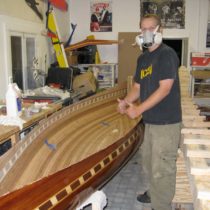Landscape Architecture for Landscape Architects › Forums › TECHNOLOGY › Why don’t professors teach more AutoCAD in schools?
- This topic has 1 reply, 16 voices, and was last updated 12 years, 1 month ago by
 Andrew Garulay, RLA.
Andrew Garulay, RLA.
-
AuthorPosts
-
October 22, 2013 at 5:29 pm #153766
Anonymous
InactiveAs a working designer I often have to teach new hires AutoCAD, sometimes from scratch. Plenty of portfolios I see on here are heavy on digital graphics: Photoshop, Sketchup, Illustrator, and various plugins. They are beautiful, although many of the techniques (fades, gradients, masking) are starting to look somewhat repetitive after 5-7 years. It’s very important to produce quality graphics, but I often find students CAD skills very lacking. They don’t understand command prompts, lisps, programming a four button mouse, or how to adjust plot styles. They are also lacking in spatial relationships: lot design, utility easements, reverse curves, compound curves, filleting, transitions in pavement, etc. I would LOVE to see a designer who understands how to do a slope analysis using topography. Therefore, the burden falls on me to teach students/ entry-level designers how to use CAD. I, too, learned AutoCAD on the job from a landscape designer. From a business standpoint, it just seems counter-productive to invest tons of time training designers skills they should really be mastering in school. Sketchup is a post-production tool. It should NOT be used as a substitute for design. I also see very simple site plans of 10-20 acres that are heavily rendered in another program. I don’t see enough complex scenarios in site design: trying to maintain the same lot count or leasable area on a site with stricter parking requirements, overlapping easements by others, etc.
October 22, 2013 at 8:28 pm #153807 Andrew Garulay, RLAParticipant
Andrew Garulay, RLAParticipantOne problem is that many professors do not know it well enough to teach it. I think that there is also too much emphasis put into some of the feel good stuff like roof top gardens, social justice, and sustainable this or that. All good stuff, but there are only so many hours in the day and you have to master the fundamentals to execute.
I was lucky enough to have a process oriented ACAD class when I was in school in ’94. I thought it was how all ACAD classes were taught. I later learned that many, if not most, are more product oriented. The process approach teaches commands and ways to use the tool. The product approach typically rockets you through a series of commands so that at the end of the semester everyone has drawn some impressive 3d something or other that they can stuff in a portfolio, but not necessarily be able to use what they learned to do anything else.
I learned far more in the first two weeks in a civil/survey office than in two years using it in studio at school, but I did know commands and easily adapted. I’m sure there are some schools with some classes that are doing it well.
October 23, 2013 at 3:21 pm #153806 Ben YahrParticipant
Ben YahrParticipantProfessors do teach AutoCad in schools – tech schools. Are we trying to raise a new generation of landscape architects or cad monkeys? The old model of designers and draftsmen is dead (or should be), but the endless discussions of cad/rendering/bim/photoshop marginalize the profession to that of production rather than design.
I firmly believe that our design programs should be focusing on design, not software. You make a great point though- design needs to respond to site conditions, especially topography. Cad can be a great tool for understanding 3d spatial relationships, but our educators should be teaching the fundamentals of this analysis that can be applied to a variety of software platforms rather than something completely trivial and proprietary like layer names.
I personally don’t like or use Sketchup often, but I would argue that it is a design tool rather than a post-production tool. In order to have a 3d model, a ton of design decisions need to be made that react to the site, and this is a good thing. Creating a Sketchup model of a site is a complex scenario, and requires more design detail than a pile of trace paper.
The question though is time. It is very easy to spend far too much time on a computer when a pile of trace paper would suffice. Time management and level of detail necessary for each phase of the design process are the types of skills that professors could be teaching.
October 23, 2013 at 3:37 pm #153805 Tosh KParticipant
Tosh KParticipantI took CAD in college (the engineering school was 3 versions behind, architecture 1 version behind), but I didn’t really learn how to use it until I started working (summer internship). So many of the commands are hard to understand in abstraction (at least for me).
My program tried throwing in 3D terrain modeling via FormZ, Civil 3D, Maya (shudder), SketchUp, MicroStation, etc until they finally settled on Rhino/AutoCAD – the emphasis was on the software as a design tool (getting bases for renderings, section studies, diagrams) rather than CD work. A few basic commands were taught, but not much in terms of xrefing, layer management, lisp, plot style management (the rough drawing was almost always tinkered in Illustrator/Photoshop). I recall there being a huge learning curve for many.
The argument I’ve heard most is cost/time – why would a student spend upwards of $75/hr in a LA program to take CAD when you could take it for far less in CC? It’s A tool, not THE tool when in school, so it’s hard to have CAD class as a core class – I’ve seen programs offer ‘workshop’ style short courses many for software that seemed to make sense (1hr classes over 3~4 wks). This way you’re exposed to basics of software packages from which a student can explore.
I assume there’s a good reason why interns are not expected to be profitable in the short term; the only expectation to have would be speed of learning (some folks just seem to pick things up quicker than others, and ‘how computers think/work’ is a rather difficult thing to understand for some).
October 23, 2013 at 4:12 pm #153804 CalicoParticipant
CalicoParticipantBack in my day, we didn’t have AutoCAD, or any of these newfangled computer thingies! If we wanted to design something, we had to start by cobbling our base map together from USGS topo, lovingly interpolating each contour line by hand, use tape to draw property lines, templates for trees, and then redo everything from scratch when the owner acquired the property next door.
We liked it! Hell, we loved it!
Every day we’d go home smelling like cat urine, because blueprints relied heavily on ammonia, and we were too stupid to realize that a blueprint machine should not operate in the same air that people breathed. If something needed to be drawn in color, we had to go to the store and pay $300 for a new set of markers because somebody had let their kids play in the studio over the weekend, and the little darlings had removed the cap from each and every marker, even the horrid Burgundy marker that nobody was allowed to use because it inexplicably bled everywhere, smelled awful, and dominated the drawing like Axe body spray in an elevator.
Then we had to pay a ton of money for somebody to photograph the rendering – which inevitably included at least one spelling error and four incorrect calculations – because scanners didn’t exist, and we were too high from ammonia and marker fumes to perform even the simplest spell check or calculations. And the photographer always needed 24 hours notice to come over and photograph the drawing, so we’d blow that off and send out the original via FedEx to the client to make his deadline. The client would then fold up the rendering to fit in his briefcase and / or use it as a napkin.
And we liked it! Hell, we loved it!
When the architect lengthened a building wall and completely jacked up the site design, the principal of the firm would don his cape and beret, put a piece of tracing paper that he could not help but call “bumwad” over the plan, move every line by a few feet (never using a scale, because he was THAT good), and then go back into his office to do whatever it was people used to do before they had mobile phones and tablets. His lackeys would then argue among themselves whether erasing everything or simply splicing a new base and redrawing everything would look better, before delegating the erasing / splicing job to the intern, who could look forward to spending another night in a studio with an unvented blueprint machine to come home smelling like cat urine.
And we liked it! Hell, we loved it!
October 23, 2013 at 4:58 pm #153803 Goustan BODINParticipant
Goustan BODINParticipantI’d break down the question like this : once working, do young professionals have a chance to learn all the analytic skills they need to make a good designer ? Do they have a chance to broaden their horizon beyond the office’s practice and have a chance to think/elaborate on other techniques, theories, aspects of the profession ?
Once working, do young professionals have a chance to learn more about the productive side of things : how to become efficient / effective /excellent through the use of tools and organizational techniques ?
Leave to schools the job of teaching what offices won’t, and focus on teaching your staff what skills you need them to master. Then, if CAD skills is what you’re after, hire draftmen.
October 23, 2013 at 5:26 pm #153802 CalicoParticipant
CalicoParticipantI don’t think you meant to reply to my rant. Oddly, with the exception the use of “CAD” of your last sentence, the post could have been written in 1963 just as easily as today. Now get back to work!!
October 23, 2013 at 5:28 pm #153801Anonymous
InactiveI graduated from an accredited program three years ago. CAD was not taught by itself. We learned it on the side, during our grading/drainage class. A professor taught us the basics (polylines, pen tables, etc), then we all toughed through a cdoc set on our own. The students who had the advantage were those who had summer internships in design firms, since they could witness office standards and workflow. As bad as it sounds, hardly any students knew how to use xrefs or manage sheet sets by the time they graduated. But boy could they render a plan in Photoshop!
A few months in my current firm shaped me up quick. I learned how to do things in a quarter of the time that I was doing them in school, thanks to a more experienced designer’s tips and shortcuts.
The problem with “toughing it out” and learning on your own is that people can develop bad habits. I work with civil engineers in my office who are examples of this. Layers are ignored, colors are chosen on whims, hatches, leaders and text become exploded due to time constraints. When younger designers can’t figure something out on a deadline, they go back to their bad drafting habits and it begins affecting entire sets of drawings.
I would have appreciated a bit more CAD training in school, but not so much as to cloud the intent of the classroom. Learning on the job will happen, hopefully it comes from an experienced designer who knows what they are doing.
October 23, 2013 at 6:49 pm #153800Dennis J. Jarrard, PLA, CLARB
ParticipantHere’s to our generation!! Cheers!!
October 23, 2013 at 8:59 pm #153799Anonymous
InactiveThank you all for thoughts and experience. It’s still hard for me to understand why you need to a 3D model to interpret a site. I did some land navigation when I was in the military and all I had was a compass and a topo map. When I was in architecture school (and then planning) I spent countless hours in the library pouring over technical manuals and reference books as I could find. I taught myself the basics of subdivision design, parking lot design, town centers, master planned communities, etc. in this method. Looking back, I was the very weird student/designer-in-training. However, I, too, didn’t actually the learn the CAD side until my first job (although I have a non-design planning degree).
October 23, 2013 at 9:06 pm #153798 Tosh KParticipant
Tosh KParticipantThe one thing I used in school that I wish I used more often at work is using the 3D modeling software’s ability to instantly calculate cut/fill based on existing and proposed terrain models – it’s not 100% ( as often the proposed is on top of finish/base materials ), but it’s a useful tool that larger contractors seem to use for estimating. Seems like a good tool to balance it out, esp for younger folks who probably couldn’t eye-ball it like the veterans can.
The disadvantage of a 3D model is that they rarely give the sense of depth in the cyber model. I still haven’t quite gotten used to it, maybe I should just pick up one of these video games…
October 23, 2013 at 9:39 pm #153797 CalicoParticipant
CalicoParticipantTo take the landscapeplanner’s original post and flip it around, why should experienced professionals expect entry level designers to be anything but… well, entry level? They will need formal training in just about everything, and that training needs to be budgeted in their first two years. This $#@! ain’t cheap! If the firm refuses to provide formal training, expect laments like landscapeplanner’s above.
October 23, 2013 at 9:58 pm #153796 Andrew Garulay, RLAParticipant
Andrew Garulay, RLAParticipantAnother way to look at this is from the perspective of a student trying to prepare him/herself to have an advantage at getting one of those few entry level jobs. Knowing what some offices, such as the one Landscapeplanner is in, think that they are not getting from recent grads gives them the opportunity to target an existing need, prepare to fill that need, and then have an advantage in getting in the door to learn everything else through experience.
It is a diverse profession. What is needed in one office is not needed in another. This is not the answer for everyone, but knowledge of opportunity that some might like to fill.
October 23, 2013 at 10:17 pm #153795Anonymous
InactiveKnowing what some offices, such as the one Landscapeplanner is in, think that they are not getting from recent grads gives them the opportunity to target an existing need, prepare to fill that need, and then have an advantage in getting in the door to learn everything else through experience.
I used that approach to get my foot in the door, and the burden fell on me to learn the ins and outs of the software and design. My boss and I spend plenty of time training new hires. I am not complaining about that. I just think that more and more graduates today focus far more time on prettying a portfolio and less time on the nuts and bolts of design in studio, and that is SOMETIMES a reflection of the faculty. Just my two cents.
October 24, 2013 at 5:34 am #153794 Goustan BODINParticipant
Goustan BODINParticipantYup, sorry I answered your rant, just meant to make a general comment. Anyways, autocad and other programs are just production tools, to each his/her own preferences. Why should they be taught at schools when there is such a wide array of suitable softwares, and some professionals won’t ever have to touch them ?
School for architects is a place to learn a though process, not a production process.
Now, going back to work 🙂
-
AuthorPosts
- You must be logged in to reply to this topic.


